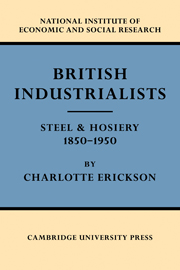Book contents
- Frontmatter
- Contents
- LIST OF TABLES
- Foreword
- Introduction
- I SCOPE OF THE INQUIRY
- II SOCIAL ORIGINS OF THE STEEL MANUFACTURERS
- III CAREERS OF THE STEEL MANUFACTURERS
- IV SOCIAL ORIGINS OF THE NOTTINGHAM HOSIERS
- V CAREERS OF THE HOSIERY MANUFACTURERS
- VI THE INTRODUCTION OF NEW TECHNIQUES IN STEEL-MAKING
- VII HOSIERY INNOVATORS
- VIII THE PUBLIC COMPANY
- Appendix A Selection of firms
- Appendix B List of firms included in steel study
- Appendix C Selection of men for steel study
- Appendix D The hosiery samples
- Appendix E Classification of fathers' occupations
- Appendix F Notes on comparisons with Population Census
- Appendix G Education
- Appendix H Marriages
- Appendix I Careers
- Appendix J Public company tables
- List of Principal Works Cited
- Index of names
- Index of companies
- General index
- PUBLICATIONS OF THE NATIONAL INSTITUTE OF ECONOMIC AND SOCIAL RESEARCH
Appendix E - Classification of fathers' occupations
Published online by Cambridge University Press: 07 October 2011
- Frontmatter
- Contents
- LIST OF TABLES
- Foreword
- Introduction
- I SCOPE OF THE INQUIRY
- II SOCIAL ORIGINS OF THE STEEL MANUFACTURERS
- III CAREERS OF THE STEEL MANUFACTURERS
- IV SOCIAL ORIGINS OF THE NOTTINGHAM HOSIERS
- V CAREERS OF THE HOSIERY MANUFACTURERS
- VI THE INTRODUCTION OF NEW TECHNIQUES IN STEEL-MAKING
- VII HOSIERY INNOVATORS
- VIII THE PUBLIC COMPANY
- Appendix A Selection of firms
- Appendix B List of firms included in steel study
- Appendix C Selection of men for steel study
- Appendix D The hosiery samples
- Appendix E Classification of fathers' occupations
- Appendix F Notes on comparisons with Population Census
- Appendix G Education
- Appendix H Marriages
- Appendix I Careers
- Appendix J Public company tables
- List of Principal Works Cited
- Index of names
- Index of companies
- General index
- PUBLICATIONS OF THE NATIONAL INSTITUTE OF ECONOMIC AND SOCIAL RESEARCH
Summary
I have adapted the abbreviated social-status categories set out on p. 322 of the Glass study, where four instead of the original seven status classes are distinguished.
Class I, according to this grouping, is described briefly as ‘professional and high administrative’ and ‘managerial and executive’. This abbreviated grouping of the original Categories I and II into a single one has been necessary because of inadequate data in two types of cases:
(1) Rarely is it possible to ascertain whether the father was owner or partner in a business employing over a hundred hands (which would have placed him in the original Class I) or in a business employing 10–99 hands (Class II). Judgment has had to be based primarily upon the nature of the business. If the nature of the product manufactured or the service offered suggests that ten or more hands were likely to have been employed, it has gone into the modified Class I. Generally speaking, the line has been drawn between retail traders of all kinds (including drapers, ironmongers, jewellers) and independent craftsmen possibly employing one or two men on the one hand, and all other business on the other. Independent craftsmen and retail traders have been put in Class II and other businessmen in Class I.
(2) Similarly one is rarely given the size of landholding for ‘farmers’ and ‘gentlemen landowners’.
- Type
- Chapter
- Information
- British IndustrialistsSteel and Hosiery 1850–1950, pp. 230 - 232Publisher: Cambridge University PressPrint publication year: 1959



